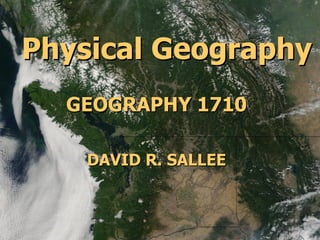Report
Share
Download to read offline

Recommended
More Related Content
What's hot
What's hot (20)
Earth's Energy Budget and solar radiation (with Animations)

Earth's Energy Budget and solar radiation (with Animations)
AS Level Physical Geography - Rocks and Weathering

AS Level Physical Geography - Rocks and Weathering
Lesson 8 periglacial processes and their landscapes and landforms

Lesson 8 periglacial processes and their landscapes and landforms
Viewers also liked
Viewers also liked (8)
Silicon Savannah - Why Nairobi Is The Next World Tech Capital

Silicon Savannah - Why Nairobi Is The Next World Tech Capital
Similar to Global Energy Balance
Similar to Global Energy Balance (20)
Master Naturalist Presentation: Weather and Climate

Master Naturalist Presentation: Weather and Climate
Energy Balance lecture 4................................ppt

Energy Balance lecture 4................................ppt
More from Steven Heath
More from Steven Heath (20)
Tertiary industries: Where should banks put their headquarters?

Tertiary industries: Where should banks put their headquarters?
Global Energy Balance
- 1. Physical Geography GEOGRAPHY 1710 DAVID R. SALLEE
- 2. Chapter 4 Atmosphere & Surface Energy Balances
- 4. Energy Pathways Transmission – Passage of energy through atmosphere or water Scattering – Changing direction of light’s movement, without altering its wavelengths Refraction – Change in speed and direction of light
- 5. Refraction
- 6. Energy Principles Insolation input On a sunny day 75% of insolation may reach the earth’s surface; on an overcast day only 15%. On average 51% of insolation is absorbed by the surface as thermal energy – 29% as direct radiation and 22% as diffused radiation; i.e. scattered by atmospheric dust , water vapor and air molecules. Albedo About 4% of the radiation reaching the surface is directly reflected, at the same wavelength, from the surface back into space. Absorption Altogether some 70% of insolation is absorbed at the earth’s surface and in the upper atmosphere but eventually all this absorbed radiation is re-radiated back into space
- 8. Albedo Is the reflectivity of a surface.
- 10. Heat Transfer Conduction – Molecule to molecule transfer Convection – Energy transferred by movement Radiation – Energy traveling through air or space
- 11. Heat Transfer
- 12. The Greenhouse Effect and Atmospheric Warming Atmosphere absorbs heat energy A real greenhouse traps heat inside Atmosphere delays transfer of heat from Earth into space
- 15. Energy Balance at Earth’s Surface Daily Radiation Patterns Simplified Surface Energy Balance The Urban Environment
- 17. Urban Heat Islands -The consistently higher temperature found in cities as compared to rural areas • The air in an urban area can be as much as 20°F (11°C) higher than rural areas surrounding the city. • Urban surfaces of metal, glass, asphalt, concrete, and stone conduct up to three times more energy than wet sandy soil and are termed urban heat islands
- 19. URBAN HEAT ISLANDS Graphic courtesy of LLBL Heat Island Group
- 20. The image spans Salt Lake City on the western (l) edge of the image to the foothills of the Wasatch Mountains on the eastern (r) edge.
- 21. • The hard, dark surfaces like pavement store heat during the day, heat that is then released at night, keeping the city hotter for longer periods of time. • A growing percentage of Earth’s population live in urban areas. • Each person then experiences a unique set of altered microclimate effects: •*Increased conduction •*Lower albedos •*Higher NET R values •*Increased run-off *Complex radiation *Complex reflection *Anthropogenic heating *Pollution
- 22. GLOBAL URBANIZATION 80 70 World N. America Europe Russia M & S America Asia Africa Percentage 60 50 40 30 20 10 0 1950 1960 1970 1980 1990 2000 Urban Population as a Percentage of Total Population in Different Areas of the World, 1950-2000
- 23. Aerial thermal photograph of Sacramento showing cool areas and hot spots.
- 24. What is Albedo? • Reflectivity + Emissivity = Albedo • Reflectivity: the percentage of incident light or electromagnetic radiation that is reflected. • Emissivity: the rate at which absorbed energy is radiated from an object.
- 25. What can be done to reduce the Heat Island Effect? • Plant more canopy type trees • Use lighter colored materials for roads and parking lots • Use high Albedo materials
